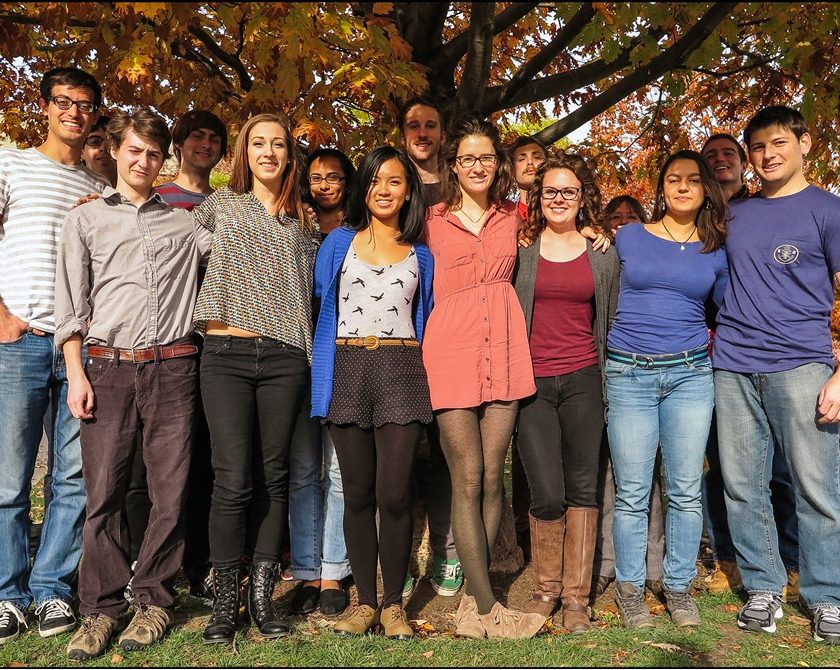(Photo: Geography 491–Senior Seminar in Geography, Syracuse University, Class of 2015, Fall 2014. Photograph by Joe Stoll.)
Geographers frequently face the challenge of explaining to people outside the discipline what it is that they actually do.
In the way? The Principal Products of Peru and the States and Capitals.
You know. The belief that Geography is the rote memorization of facts associated with places. Or, that it's about having the ability to identify every global location on a map.
Pushing back against PPP seems to be an ongoing exercise for those of us in higher ed. We want to to turn students on to the exciting possibilities that our discipline could hold in store for them. (At the same time, we also want to convince administrators–the higher-ups–that we do very serious and relevant work.) But even with all of the K-12 curriculum reforms that since the early 1980s have gradually put geography back into social studies textbooks, we still have to fight the PPP battle. We have to re-educate students that geography isn't rote memorization of locations and geo-trivia. So we set out to immerse them in this other kind of geography . . . the geography of spatial thinking, spatial representation, spatial theory. Goodbye, PPP!
Notably, sometimes we do this effectively. When we do, students fall as unabashedly in love with the spatial kind of geography as we are in love with it . . . and then they face our problem.
How do they convey to parents and prospective employers what geography REALLY is?
For several years now, I've been leading the senior seminar in geography (a required capstone course) at Syracuse University–GEO 491. The Classes of 2012, 2013 and 2014 have–collectively and rather unwittingly–made me see the PPP/Spatial problem and its solution in a different way. Maybe I had been making a PPP mountain out of a molehill.
Their philosophy: don't fight PPP. Embrace it, have fun with it, let it attract others who have fun with it . . . and then . . . slip in the notion that PPP isn't ALL that geography is . . . look at all of these other cool things you can do with it! And once your audience is marvelling at that . . . then start working in the idea that geography deals with serious issues: food insecurity, climate change, homelessness, deindustrialization, natural hazards and disasters, human trafficking, social vulnerability, environmental racism, etc. etc. etc. And then . . . start providing the examples of how former students have actually parlayed this initial love of PPP, into this skill set, into a constellation of concerns, into careers that may not carry the title of "geographer" but certainly make use of the practice of geography every day. But never be afraid of PPP . . . just know how to put it in its 'place', as it were.
This year, the Class of 2015/Geo 491 moved–without cajoling on my part–toward their articulation of this philosophy as they created–from scratch–a website. They used it to present a lighter-hearted, yet still serious, perspective on Geography, targetting as their website audience their younger/geo-neophyte selves: high school students who may only know the PPP version of geography. They seek to recruit them to an expanded vision of geography (that includes PPP and spatial analysis), to geography as a potential college major, AND to Syracuse University Geography itself.
Out of a class of 17, however, only one or two had any coding or web design experience. Only a handful had any experience in advertising or public relations. But they all shared this love of geography in its many facets–PPP as well as GIS as well as spatial theory. They wanted to communicate all of this with others.
To do so, over the course of the semester, they worked with Syracuse University's office of Online Learning Services, who taught them how to make a sophisticated website using WordPress. They also went out and did research about the SU Geography Department–talking to professors and alumni . . . combining entertaining and seriously compelling aspects of these individual's professional and personal lives in the website's text and imagery. They also looked at themselves–what they liked to do as individuals and in groups, where they hoped to head in the future, how much progress they had made. They found ways to convey this that they think will resonate with young adults four years "behind them."
The result of all this work? Geocuse: An Underground, Undergraduate Geography Website created for prospective students by current students http://geocuse.syr.edu It is a lively rendition of what our field is about, what current and former students are doing with it, how they believe they are going to use it to change the world. The site exudes infectuous passion . . . . and does it publicly. No pomposity, no staidness . . . just informative and straightforward enthusiasm about Geography, PPP/spatial-warts and all, and the wonderful possibilities.
I stand in humble awe of what they created. These students may in fact be Geography's best ambassadors.
Congratulations GEO 491. Job well done!

You must be logged in to post a comment.